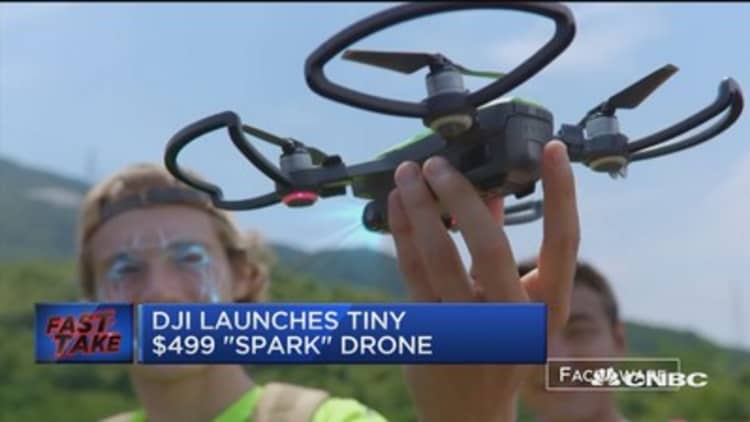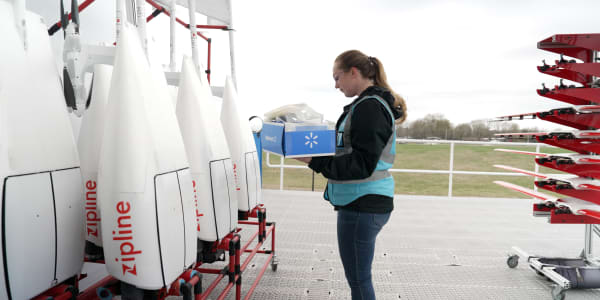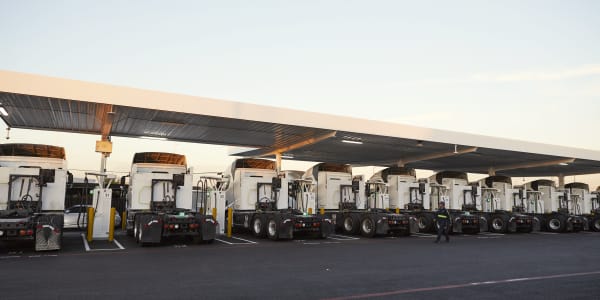In the past year, the West has suffered heavy losses in a new form of global air conflict.
Berkeley-based 3DR has downsized and ceased manufacturing drones. GoPro's Karma drones lost power mid-air and had to be recalled, though they are now back on the market. Paris-based Parrot slashed 35 percent of its drone team. San Francisco-headquartered Lily Robotics shuttered its doors.
But with Western drone manufacturers floundering and shifting business models, one company's fortunes are soaring: China's DJI Technology. Today the Shenzhen-based company dominates the global drone hardware market, which is forecast to surpass $11 billion by 2020.
"DJI has done everything right," said Chris Anderson, co-founder of 3DR, which had been the No. 2 drone maker but has transitioned into an aerial software company, helping companies precisely capture images and data. "They've innovated. They have globally branded and distributed, which is unusual for a Chinese company."
DJI's design expertise, vertical integration and declining retail prices have allowed the company to corner three-fourths of the consumer market share.
"I don't see a way to compete with DJI on consumer [hardware]," Anderson said.
DJI has a reported $10 billion valuation but no plans to go public as its evolution continues.
In May, DJI introduced its smallest and lightest drone ever, the $499 Spark quadcopter, a four-rotor drone that can be controlled with hand gestures. Behind this launch were years of evolution in a field previously overrun by clunky drone models.
I don't see a way to compete with DJI on consumer [hardware].Chris Andersonco-founder of 3DR
In 2006, CEO Frank Wang, now 37, founded DJI. Historically, multirotor drones were unstable and difficult to control. While studying at Hong Kong University of Science and Technology, Hangzhou-native Wang started to change that. Initial DJI drones required DIY soldering and wiring, making them appealing to hobbyists. The company grew as the drones developed in technology, becoming preassembled, easier to fly and longer-lasting. DJI invested in creating proprietary technologies, like obstacle avoidance and cameras
"We've been trying to make it easy so more people could use it," said spokesman Kevin On.
Previously, tourists, adventurists and videographers attached third-party cameras to DJI drones. To stabilize footage, DJI developed its own cameras and gimbals, the devices that stabilize a camera aboard a sometimes unsteady drone in flight.
"They've done particularly good work on the camera and gimbal side. Best in the industry," Anderson said.
DJI also partners externally. It acquired a minority stake in high-end Swedish camera manufacturer Hasselblad, which led to the creation of a drone capable of flying a 100-megapixel camera.
More from CNBC Disruptor 50:
How to make money flying drones
Early testing is in: Robots should us more than we fear them
Commercial space start-ups hitting exit velocity
Investment in product innovation has enabled growth. More than one-fourth of DJI's 8,000-plus employees are R&D or engineering staff. Operations are scattered across 17 strategic locations, including Shenzhen for manufacturing. "There's only one place in the world where you can [manufacture] efficiently and cheaply and create products with that level of sophisticated integration. That's Shenzhen," Anderson said.
DJI also taps into global talent with worldwide offices: Hong Kong handles logistics, Tokyo develops cameras, and programmers write code in San Mateo, California. A creative team works out of Los Angeles while a New York office handles public affairs and government relations.
As consumer drone uses broadened, product offerings expanded. DJI's flagship series, the Phantom, costs USD $500–$1,500. When the Phantom 4 first shipped last year, it was done exclusively through Apple stores, a minor coup for DJI. "The brands align," On said. "The customers share the same kind of emotions and needs about the products."
DJI seeks mainstream acceptance. "Not just for the geeks, techs and enthusiasts. That's our goal. Making the product relevant to different people," On said. Marketing campaigns highlight everyday drone applications, not product specs.

Holding the $1,000 Mavic Pro, known for its portability, in his palm, DJI marketing specialist Chin Lad said, "Some people just want a nice drone that they can stick up in the air with a reliable camera and reliable flight distance."
Beyond the mass market, enterprises are deploying drones for various reasons.
On the commercial side, DJI emphasizes five categories: cinematography; agriculture; energy-sector inspection; infrastructure and construction; and emergency response.
"There is so much potential," On said.
Drones are creating sub-economies
DJI's Matrice has an open software and hardware platform. Warehouse managers attach RFID readers for inventory tracking. Firefighters attach gas sensors to detect hazards. Farmers attach RGB cameras to monitor crops. Energy inspectors attach thermal-imaging cameras to survey power lines.
Eighteen months ago DJI launched its Agras MG-1 drone designed for crop spraying. Citing forecasted food shortages, On said, "This is a world problem we're trying to address, having tools that allow people to become more efficient and more cost effective in producing crops."
Other commercial applications include delivering packages and transporting humans, but these aren't currently strategic priorities. On said logistics is exciting, but given dense populations, tall buildings and competing airspace needs, delivering purchases door-to-door in metropolises is difficult today. Delivering supplies to rural areas or remote islands, however, is possible.
"[Drones] are going to revolutionize a lot of businesses globally across various industries," said Ian Tansey, who after two decades working in financial services founded London-based ProDroneWorx last year.
ProDroneWorx provides surveying, volume measurements, and 3D modeling to architectural, construction, and engineering firms. Compared to mortals, drones more cheaply, efficiently, safely, and accurately inspect buildings, bridges, roads, waterways, railway tracks, communications towers, solar farms and chemical disasters.
Tansey uses the DJI Inspire 2 and X5S camera, but third-party lenses. DJI platforms do sync with some third-parties, but Tansey hopes for more. "Integration of different software and hardware products across platforms is key," he said. Not all sensors work on DJI drones, nor do certain measuring and modeling software programs.
DJI, as the dominant drone maker, will face atypical business and reputational risks, from hacking to terrorists reportedly deploying drones. "If they have the wrong intentions, this is something they need to be held responsible for [by authorities]," On said.
One countermeasure is geofencing, placing invisible barriers around targets including airports, skyscrapers, military bases, prisons, and tourist attractions. DJI monitors happenings globally and geofenced Iraqi and Syrian locations recently. During the Rio Olympics, they geofenced stadiums to increase safety for people on the ground.
The US drone market's evolution
U.S. drone-related start-ups attracted $240 million in 2016, a 36 percent annual jump, but more funding is going toward services and software, where margins are higher.
"VCs have recognized that we've now entered the era where it's not about the drone. It's about making data useful," Anderson said. "There's still a lot of evolution that's going to come on the commercial side."
"With matters that raise national security concerns, we will do our best to ensure safety and responsible flying," On said.
U.S. regulatory gridlock has hampered domestic development. Last month at a White House discussion on emerging technologies, drone industry executives pushed for explicit rules regarding commercial drone applications.
Anderson, who partakes in FAA regulatory committees, said, "We're not there yet," but "I'm very encouraged."
— By Joshua Bateman, special to CNBC.com





